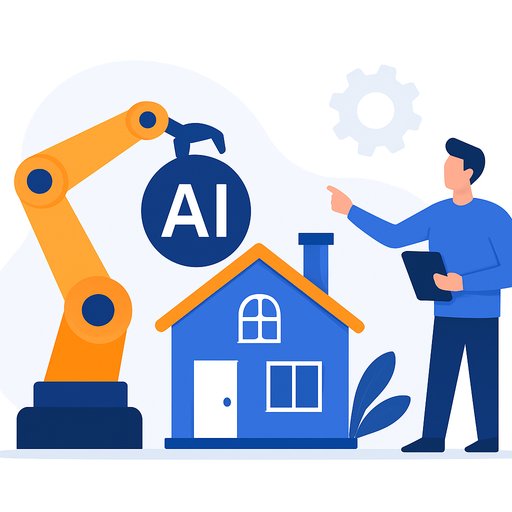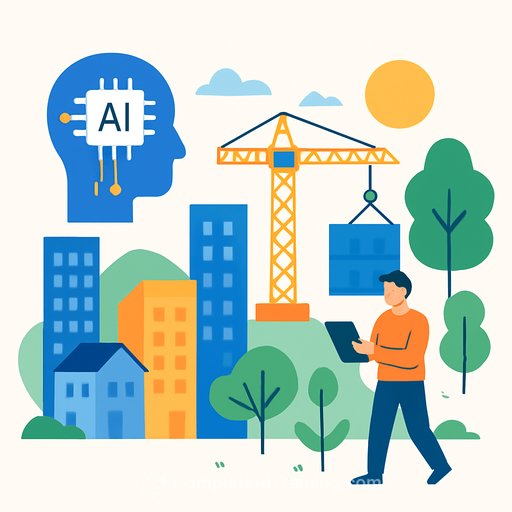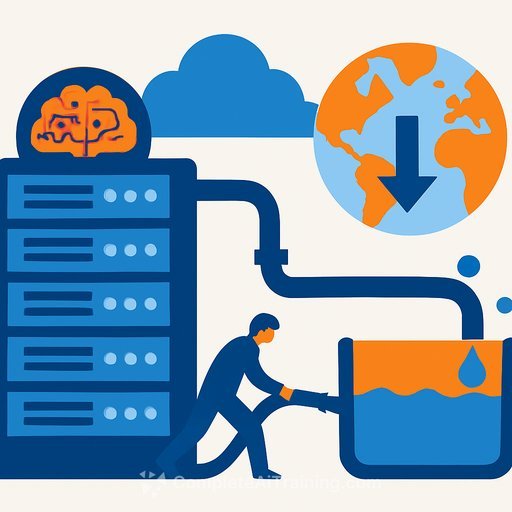Generative AI Is Rewriting How Commercial Real Estate Works
Generative AI is moving commercial real estate from manual workflows to automated, creative problem-solving. It's not a feature upgrade. It's a step-change touching operations, acquisitions, marketing, asset management, and even design.
As of late 2025, more than 72% of global real estate owners and investors say they're committing meaningful capital to AI-enabled solutions. The signal is clear: AI isn't a side project-it's becoming core infrastructure.
The Creative Engine: Why GenAI Is Different
Traditional AI predicts and classifies. Generative AI creates-text, images, 3D models, and optimized designs-by learning patterns from massive datasets. That creative output is where the efficiency gains compound.
Where Value Shows Up Now
- Property Operations: Real-time models read occupancy, weather, and schedules to make micro-adjustments to HVAC and lighting. Owners report HVAC energy savings around 15.8%. LLM chatbots handle tenant FAQs, maintenance, and rent collection 24/7 with fewer tickets bouncing to staff.
- Acquisition Strategy: Due diligence drops from weeks to minutes. Tools scan zoning, environmental reports, leases, and loan docs to extract terms, spot inconsistencies, and flag risk. Market screening, automated underwriting, and scenario simulation compress deal cycles.
- Asset Management: Live portfolio health, capital performance, and budget forecasts in one place. Lease abstraction is near-instant-rent bumps, options, termination rights-plus automated tracking of post-close deliverables so deadlines don't slip.
- Marketing and Leasing: AI drafts SEO-ready property copy and market briefs on command. CRM analysis enables personal outreach at scale. Photoreal virtual staging and renovation concepts are generated from text or plans, cutting cost and time versus physical staging.
- Design and Construction: Algorithms propose layout options that account for daylight, noise, and energy use. Designers iterate faster with text-to-3D, quick renderings, and material studies, speeding early-phase decisions.
What Experts Like-and What Keeps Them Cautious
Leaders expect serious productivity gains and new revenue streams. The concerns are real: data quality, hallucinations, privacy, and bias. The fix is disciplined data strategy, clear governance, and human review.
Demand for GenAI skills is climbing across acquisitions, asset management, PM, and design teams. Firms that upskill early will move faster and make fewer expensive mistakes.
Who Benefits-and Who Gets Pressured
- Major Real Estate Firms: JLL (NYSE: JLL) with JLL GPT and Hank, Zillow (NASDAQ: Z), CBRE (NYSE: CBRE), and Compass (NYSE: COMP) are pushing AI into daily workflows. PropTech players like CoreLogic, Redfin (NASDAQ: RDFN), Keyway, Zuma, Plunk, and Entera are active.
- AI Platforms & Infrastructure: Google (NASDAQ: GOOGL), Microsoft (NASDAQ: MSFT), and Amazon (NASDAQ: AMZN) supply cloud and enterprise integrations. Foundational model providers (e.g., OpenAI) monetize via licensing and APIs.
- Data Center Operators/Developers: Vantage and Lincoln Property Company gain from AI's compute appetite.
- PropTech Startups: Lower barriers mean faster niche solutions and "bespoke" tools built atop existing models.
Expect consolidation around a handful of model providers. Data becomes the moat-firms with high-quality proprietary data will train better CRE-specific models. Several services feel pressure: manual diligence, generic SaaS, routine marketing/brokerage tasks, valuation workflows, and portions of design/rendering.
How to Win: Practical Strategy
- Data-first: Clean, labeled, permissioned data. Decide what's proprietary vs. third-party.
- Integrated stack: Embed GenAI across acquisitions, leasing, ops, and reporting instead of one-off pilots.
- Human-in-the-loop: Let AI do the repetitive work. Keep people on judgment, relationships, and final sign-offs.
- Governance and security: Clear policies for privacy, model selection, testing, and audit trails.
- Talent: Upskill your teams and recruit prompt engineers, data engineers, and AI product owners.
- Iterate fast: Small pilots, measurable ROI, then scale.
AI's Broader Shift (Why This Moment Matters)
Key milestones built to this moment: GANs and VAEs (2014), the Transformer (2017), then LLMs like GPT (2018) and ChatGPT (2022). Today's trendline is multimodal AI, industry-tuned models, agentic systems, and hybrid human-AI workflows.
Implications You Should Plan For
- Societal: Routine tasks will automate, while new roles emerge in oversight and orchestration. Expect more personalized tenant and investor experiences and smarter, greener buildings.
- Economic: Productivity lifts, lower OPEX, and fresh business models. PropTech growth is projected, with the GenAI-in-real-estate market estimated at USD 1,047 million by 2032.
- Ethical: Bias, privacy, security, accuracy, IP, and accountability require clear policies and continuous validation. Training large models also has environmental costs to manage.
Near-Term vs. Long-Term
- Near term: Faster underwriting and budgeting, automated marketing/reporting, smarter building ops, better virtual tours and renovation tools, plus gains in legal/HR support.
- Long term: More demand for AI-ready real estate (advanced data centers), new investment models, experience-led design, scenario simulation beyond simple forecasting, and momentum toward autonomous property management.
Key Challenges to Tackle Now
- Data quality, coverage, and labeling across leases, ops, and financials
- Validation and human oversight to reduce hallucinations and false positives
- Legacy tech integration and vendor sprawl
- Clear policies for privacy, bias testing, and model selection
- Workforce impact and skills gaps-build training plans and new roles
What the Market Expects
Analysts project strong growth for GenAI in real estate, and estimates suggest $110-$180B+ in value creation. Most experts agree: AI will augment professionals more than replace them, shifting effort from grunt work to higher-value decisions and relationships.
What to Watch Next
- Speed and depth of GenAI adoption across asset classes and functions
- Specialized tools built for CRE use cases (diligence, lease ops, energy, marketing)
- Data strategies, privacy guardrails, and measurable ROI from pilots
- Multimodal AI upgrades that blend text, image, and video for richer property experiences
- Policy and standards for accuracy, safety, and accountability
Action Plan: First 90 Days
- Week 1-2: Pick two use cases with clear ROI (e.g., lease abstraction and energy optimization). Define success metrics.
- Week 3-6: Run pilots with a small team. Compare baseline vs. AI-assisted cycles, error rates, and cost.
- Week 7-10: Draft data and governance policies. Establish prompts, red-teaming, and human review steps.
- Week 11-13: Build the rollout plan and training path for adjacent teams. Negotiate enterprise licensing and integration.
Upskilling Your Team
If you're planning structured training for analysts, asset managers, PMs, or marketing teams, explore targeted AI curricula by role and skill level.
Bottom Line
GenAI delivers practical gains across the CRE lifecycle-faster diligence, smarter buildings, richer marketing, cleaner reporting, and quicker design iterations. The firms that win will treat data as a product, keep humans in the loop, and train their people to work with AI every day.
The opportunity is big. The playbook is straightforward. Execute on a few high-impact use cases, prove ROI, and scale with discipline.
Your membership also unlocks:





